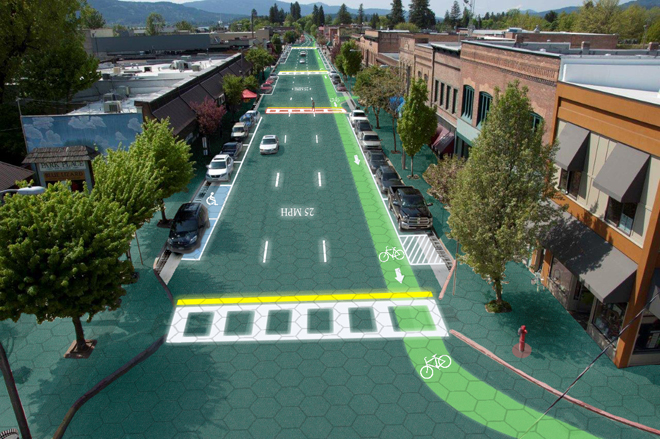The answer to America's power needs: Solar roads
Driving on glass roads isn't as dangerous or silly as it sounds

In years to come we could all be driving on glass roads.
You think that sounds ridiculous? Well, think about it like this: A nation of drivers, the U.S. has nearly 18,000 square miles of roads, an area that's bigger than the entire states of New Hampshire and Massachusetts combined — and the technology already exists to build solar cells into all of that pavement, turning the entire country's roadways into a massive power generator.
The Solar Roadways project wants to re-pave the country with solar roads. The Solar Road Panels can be installed on roads, parking lots, driveways, sidewalks, bike paths, playgrounds — literally any surface under the sun. Yes, they are covered in a kind of glass, but the glass is strong and grippy enough to drive on — apparently they can withstand trucks weighing up to 250,000 lbs — while generating power to light the road, charge electric vehicles, and melt ice and snow. "You first mention glass, people think of your kitchen window," Solar Roadways' Scott Brusaw told Fast Company. "But think of bulletproof glass or bomb resistant glass. You can make it any way you want. Basically bulletproof glass is several sheets of tempered glass laminated together. That's what we have, only our glass is a half inch thick, and tempered, and laminated."
The Week
Escape your echo chamber. Get the facts behind the news, plus analysis from multiple perspectives.

Sign up for The Week's Free Newsletters
From our morning news briefing to a weekly Good News Newsletter, get the best of The Week delivered directly to your inbox.
From our morning news briefing to a weekly Good News Newsletter, get the best of The Week delivered directly to your inbox.

But the key thing is that if every road in the country was covered, according to Solar Roadways' tests, they would generate up to three times more electricity than the country uses now. That would meet America's energy needs for years to come while eliminating three quarters of America's carbon emissions from vehicle emissions and burning fossil fuels like coal for electricity. And because they generate electricity, solar roads could over the lifetime of the panel offset some (or ideally, all) of the undeniably large cost of resurfacing every road in the country. That is pretty stunning — American renewable energy independence just from road surfaces, not taking into account other solar panels mounted on roofs, or (the visually unpopular) wind turbines.
This technology is piggybacking on the fact that solar panels are becoming more and more efficient, so the energy yields will only improve as the technology advances. Solar has defied its critics by dropping massively in price in recent years and is already as cheap as conventional electricity in Spain and Germany. Thanks to that drop, these kinds of wildly ambitious projects are becoming viable. While the final cost of a section of solar road is still unknown (although the more that are manufactured, the cheaper it is likely to get), Solar Roadways has already secured two contracts from the U.S. Federal Highway Administration for research and development of the paving system, and is now looking to raise funding for more wide-scale production.
Additionally solar roads have the potential to replace America's aging electric grid, and deliver high-speed internet, cable TV, and telephone to anywhere with a road. The Solar Roadways carry power and data from the power-producing road to homes and businesses. This could revolutionize not just America's grid, but also provide much needed competition to America's high price and low-speed cable and internet monopolies.
Of course, the one stumbling block is storage. Solar energy is generated rather sporadically — the highest generation occurs when the sun is out — not continuously like nuclear power, or coal-fired power stations. This means that to go 100 percent renewable, there would have to be a revolution in storage — homes and businesses would have to be able to cheaply store energy generated in the daytime for use at night. Fortunately the nascent electric car industry and high-demand for higher-efficiency laptops and cellular phones, as well as the desire for renewable energy storage mean that there are already plenty of higher capacity, lower cost, and faster-charging battery solutions in the pipeline.
A free daily email with the biggest news stories of the day – and the best features from TheWeek.com
That means this is one of the most exciting energy technologies to have developed in recent years, and has the potential to completely revolutionize America's energy industry. Driving on glass doesn't have to mean a flat tire.
John Aziz is the economics and business correspondent at TheWeek.com. He is also an associate editor at Pieria.co.uk. Previously his work has appeared on Business Insider, Zero Hedge, and Noahpinion.


